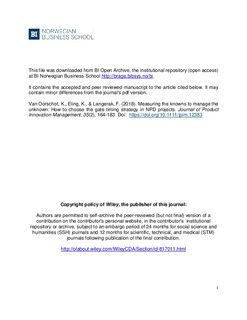| dc.contributor.author | van Oorschot, Kim | |
| dc.contributor.author | Eling, Katrin | |
| dc.contributor.author | Langerak, Fred | |
| dc.date.accessioned | 2018-06-04T07:31:49Z | |
| dc.date.available | 2018-06-04T07:31:49Z | |
| dc.date.created | 2017-09-08T15:39:43Z | |
| dc.date.issued | 2018 | |
| dc.identifier.citation | Journal of Product Innovation Management, 2018, 35(2), 164-183 | nb_NO |
| dc.identifier.issn | 0737-6782 | |
| dc.identifier.issn | 1540-5885 | |
| dc.identifier.uri | http://hdl.handle.net/11250/2500094 | |
| dc.description.abstract | Stage‐wise timing of new product development (NPD) activities is advantageous for a project's performance. The literature does not, however, specify whether this implies setting and adhering to a fixed schedule of gate meetings from the start of the project or allowing flexibility to adjust the schedule throughout the NPD process. In the initial project plan, managers and/or development teams often underrate the time required to complete the project because of task underestimation. Although the level of task underestimation (i.e., the unknown) is not identifiable at the start of the project, our study argues that project managers and/or teams can manage the unknown by measuring three project conditions (i.e., the knowns) during front‐end execution, and use their values to select the best gate timing strategy. These project conditions entail: (i) the number of unexpected tasks discovered during the front‐end, (ii) the willingness of customers to postpone their purchase in case the execution of these unexpected tasks would lead to a delayed market launch, and (iii) the number of unexpected tasks discovered just before the front‐end gate. Together these conditions determine whether a more fixed or more flexible gate timing strategy is most appropriate to use. The findings of a system dynamics simulation corroborate the supposition that the interplay between the three project conditions measured during front‐end execution determines which of four gate timing strategies with different levels of flexibility (i.e., one fixed, one flexible, and two hybrid forms) maximizes new product profitability. This finding has important implications for both theory and practice as we now comprehend that the knowns can be used to manage the unknown. | nb_NO |
| dc.language.iso | eng | nb_NO |
| dc.publisher | Wiley | nb_NO |
| dc.title | Measuring the Knowns to Manage the Unknown: How to Choose the Gate Timing Strategy in NPD Projects | nb_NO |
| dc.title.alternative | Measuring the Knowns to Manage the Unknown: How to Choose the Gate Timing Strategy in NPD Projects | nb_NO |
| dc.type | Journal article | nb_NO |
| dc.type | Peer reviewed | nb_NO |
| dc.description.version | acceptedVersion | nb_NO |
| dc.source.journal | The Journal of product innovation management | nb_NO |
| dc.identifier.doi | 10.1111/jpim.12383 | |
| dc.identifier.cristin | 1492241 | |
| dc.description.localcode | 2, Forfatterversjon | nb_NO |
| cristin.unitcode | 158,4,0,0 | |
| cristin.unitname | Institutt for ledelse og organisasjon | |
| cristin.ispublished | true | |
| cristin.fulltext | postprint | |
| cristin.qualitycode | 2 | |
